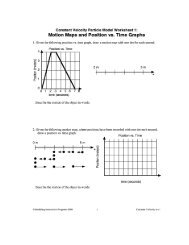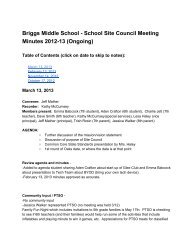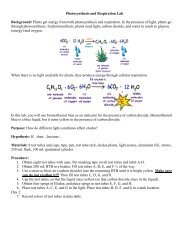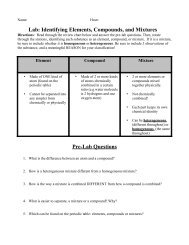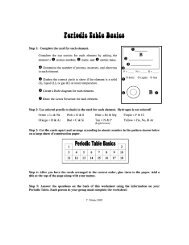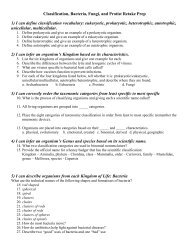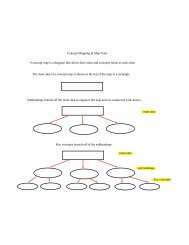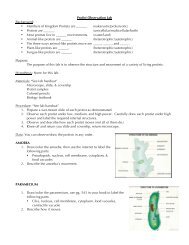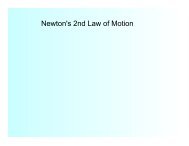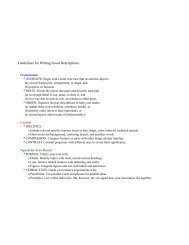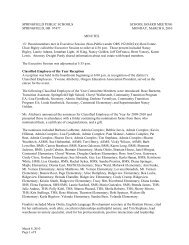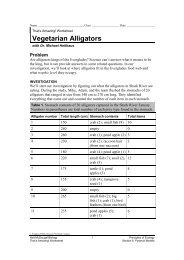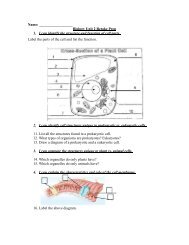Novel Study Jobs
Novel Study Jobs
Novel Study Jobs
You also want an ePaper? Increase the reach of your titles
YUMPU automatically turns print PDFs into web optimized ePapers that Google loves.
EACH WEEK<br />
SUMMARIZER: Prepare a brief summary of the week’s reading. Use the questions below to help<br />
you decide what to include. In some cases, you might ask yourself what details, characters, or events are so<br />
important that they would be included on an exam. If it helps you to organize the information, consider<br />
making a numbered list or a time line.<br />
Guiding Questions:<br />
• What are the most important events in the section you read?<br />
• What makes them so important?<br />
• What effect do these events have on the plot or the other characters?<br />
• What changes - in plot, character, or tone - did you notice when you read?<br />
TO DO:<br />
1.) keep a list of characters with traits; keep rough plot notes<br />
2.) provide a brief synopsis of the earlier plot (if applicable) for the audience<br />
3.) discuss any newly introduced characters<br />
4.) give examples of literary devices from story (foreshadowing, etc.)<br />
5.) sufficient length: one page, on average<br />
WORD WATCHER: While reading the assigned section, watch out for words worth knowing.<br />
These words might be interesting, new, important, or used in unusual ways. It is important to indicate the<br />
specific location of the words so the group can understand these words in context.<br />
Guiding Questions:<br />
• Which words are used frequently, or in unusual ways?<br />
• What words seem to have special meaning to the characters or author?<br />
• What part of speech is this word?<br />
• What is the connotative / denotative meaning of this word?<br />
TO DO: 1.) keep a running list of words from portion read (with pg. #)<br />
2.) choose one word to elaborate on (EXACTLY like example below)<br />
3.) characters or place names cannot be a part of this list<br />
4.) words are listed and defined in order to explain their use in the situation, story,<br />
period, etc. – so show why the word is used (not just what it means)<br />
5.) definition must be understandable (don’t use unfamiliar words)<br />
EXAMPLE<br />
- rumpled – p. 172 “Seemingly without any action of the wind, his fair hair was<br />
rumpled all over his head”<br />
rumpled, adj. – crushed, wrinkled, in disorder<br />
As Johnny was talking with Cilla, she was referring to her relationship with Rab<br />
(which Johnny was not aware of) when Johnny stuck out his lower lip in shame and<br />
his hair appeared messed up. His body language showed his apparent shame and<br />
disappointment.
ONCE<br />
ILLUSTRATOR: Your role is to draw what you read. This might mean drawing a scene as a cartoonlike<br />
sequence or a “frozen” scene so readers can better understand the action. You can draw maps or<br />
organizational trees to show how one person, place, or event relates to the others. Explain how your<br />
drawing relates to the text. Label your drawings so we know who the characters are. Make your drawing<br />
on a separate sheet of paper.<br />
Guiding Questions:<br />
• Why did you choose this scene to illustrate?<br />
• How is this scene important to the story?<br />
• Why did you choose to draw it the way you did?<br />
• What do we see – i.e., who and/or what is in the picture?<br />
• What, if anything, did drawing it help you see that you had not noticed before?<br />
• What are you trying to accomplish through this drawing?<br />
TO DO:<br />
1.) while you read, note pg. #s for ideas to illustrate<br />
2.) spend 1 hr. min. on picture (it’s obvious when you don’t)<br />
3.) please do not use notebook paper (lined) for drawing<br />
4.) color on picture not necessary (pencil sketch is fine)<br />
5.) describe the scene and why you chose it – 1/2 pg. minimum<br />
ILLUMINATOR: You find passages your group would like to / should hear read aloud. These<br />
passages should be memorable, interesting, puzzling, funny, or important. Your notes should include the<br />
quotations but also why you chose them and what you want to say about them. You can either read the<br />
Guiding Questions:<br />
• What is happening in this passage?<br />
• Why did you choose this passage?<br />
• What does this passage mean, or what is it discussing?<br />
• How should you present this passage?<br />
• Who is speaking or what is happening in this passage?<br />
• What is the most unique aspect of this passage – and why is it unique?<br />
• What did this quotation / passage make you think about when you read it?<br />
• What makes this passage so confusing, important, or interesting?<br />
TO DO: <br />
1.) while you read, note pg. #s for ideas to illuminate<br />
2.) write down quoted section (minimum 4-5 sentences)<br />
3.) include page number of selection<br />
4.) write thorough response to selection (1/2 pg. minimum)<br />
5.) present selection dramatically (practice 2-3 times, with help)
TWICE<br />
CONNECTOR: Your job is to connect what you are reading with what you are studying or with the<br />
world outside of school. You can connect the story to events in your own life, news events, political events,<br />
or popular trends. Another important source of connections is books you’ve already read. The connections<br />
should be meaningful to you and those in your group.<br />
Guiding Questions:<br />
• What connections can you make to your own life?<br />
• What other places or people could you compare this story to?<br />
• What other books or stories might you compare to this one?<br />
• What other characters or authors might you compare to this one?<br />
• How does this section relate to those that come before it?<br />
TO DO: 1.) jot down ideas as you read, noting page numbers<br />
2.) write 1/2 page minimum (with two separate connections, min.)<br />
3.) connections must be of significance, not common or obvious<br />
(NOT – the protagonist is a human and so am I)<br />
4.) connections must each be well explained (3-5 sentences), NOT just a simple<br />
answer to one of the guiding questions above
NOVEL STUDIES – Daily tasks<br />
1. Each day that you read, use a new sheet of paper, and date the page.<br />
2. Before you begin reading each day (if you’re not already done reading), write down the<br />
page number you started on below the date (ex. Start: p.10) . At the end of the period,<br />
also write the page you ended on (ex. End: p. 44).<br />
3. Organize a section of your paper for each of the jobs:<br />
SUMMARIZER, WORD WATCHER, ILLUSTRATOR, ILLUMINATOR, CONNECTOR. The<br />
summarizer area should be the largest section, as it will require the most information. I suggest<br />
using the top half of the paper. The bottom half of the paper can be divided into four columns.<br />
Each column can be titled by one of the four remaining jobs listed above. The summarizer and<br />
word watcher jobs are required for each presentation. The illustrator and illuminator jobs need to<br />
be completed once each, and the connector needs to be done twice. You will decide on which<br />
section of their novels those pieces will be done. I suggest writing information in all columns<br />
while reading, and upon completion of the section, decide which of the optional jobs to do.<br />
4. You’ll be doing the job of SUMMARIZER for each presentation. Here, you’ll need to<br />
keep a list of characters (with short descriptions). Describe the setting (time and place)<br />
here too. You’ll also need to take notes on complications (rising action) as they relate to<br />
the conflict. Keep these notes in chronological order. Note changes in mood or hints<br />
toward theme. Write down the point of view. You should also write down examples of<br />
literary devices – foreshadowing, flashback, irony, etc.<br />
5. As you run across words that would qualify for the WORD WATCHER job, jot down the<br />
word and the page number. You can decide later which word you’ll be expanding. You’ll<br />
need the page number to go back and explain it. This will also be done each time.<br />
6. For the ILLUSTRATOR job, write down page numbers and short descriptions of possible<br />
illustration ideas. This job is only required for one presentation of your choice.<br />
7. Similar to above, jot down page numbers and brief reports for possible scenes for the<br />
ILLUMINATOR job. This is also only required for one presentation.<br />
8. The CONNECTOR job is required for two presentations of your choice. As you read,<br />
jot down ideas of things that you can connect with. Also get page numbers, so you can<br />
check back later to further explain the details of the link.<br />
9. Want Extra Credit? Create a book review podcast - make arrangements with Mr. Gault.



